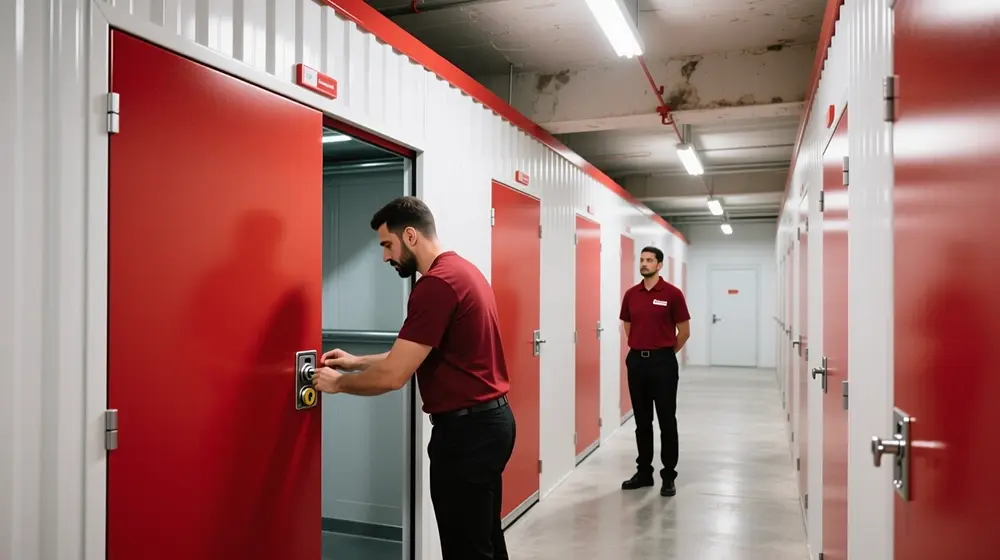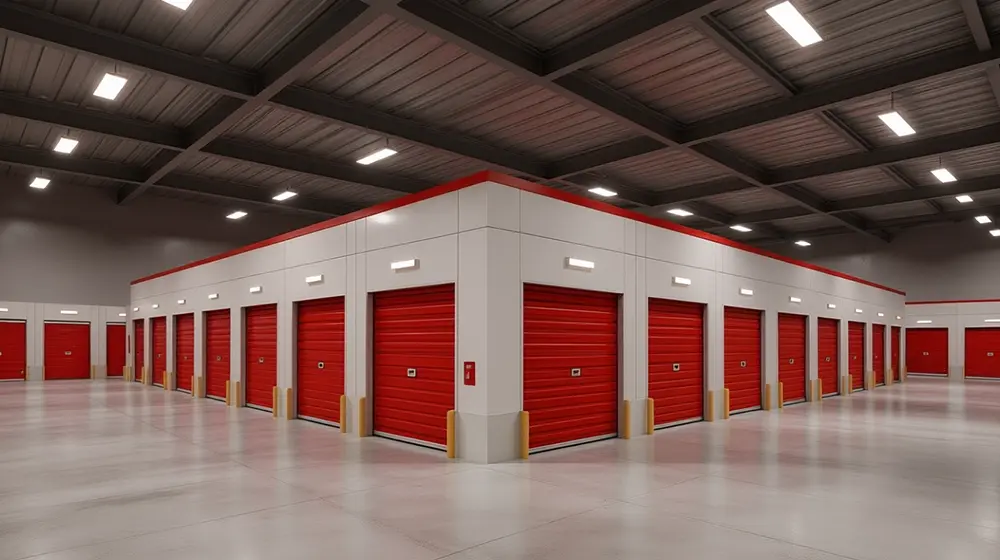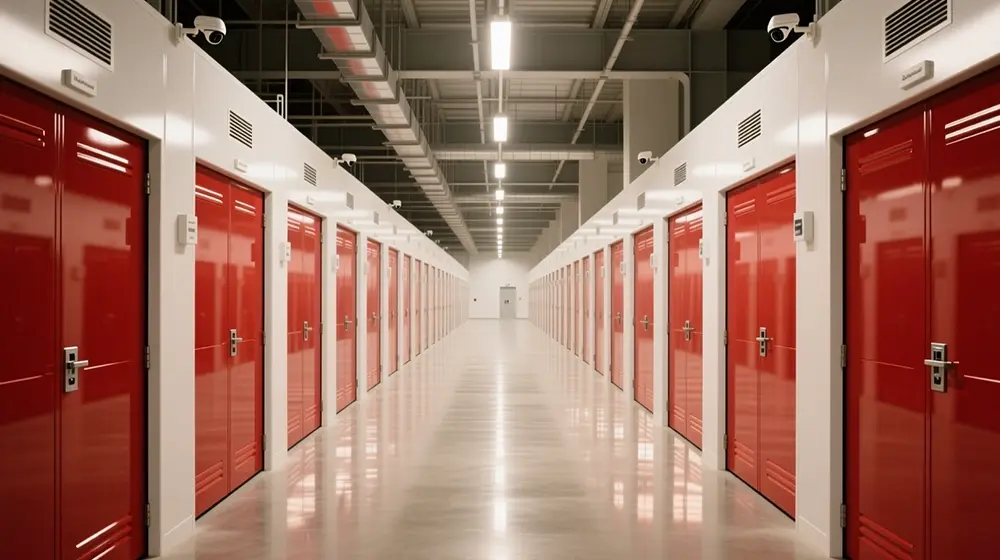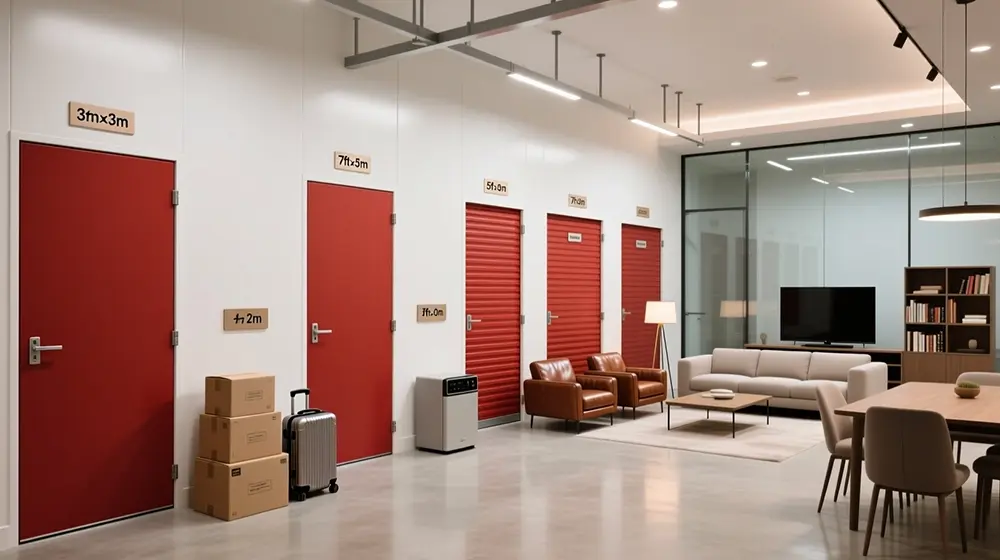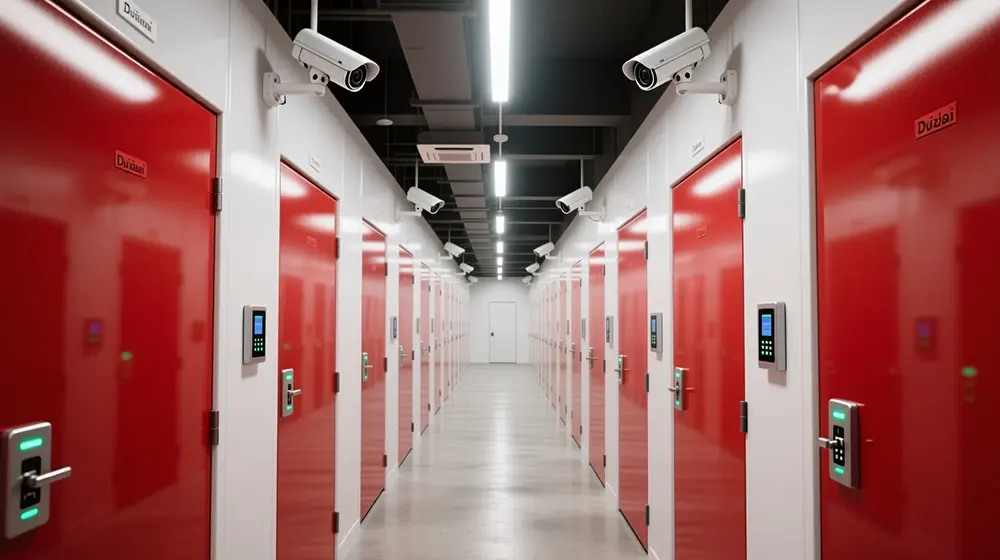Heat and humidity create material risk in Abu Dhabi. Relative humidity reaches an average maximum near 78.1 %. Mold risk rises when warm air meets high humidity. Compliance sets life-safety baselines. VAT adds 5 %.
Renters report damage to wood, paper, leather, and electronics under poor control. Conservator guidance favors humidity control near 35 to 55 % for sensitive materials. Fire systems require documented testing under the national code.
This guide answers one question fast. Which 8 red flags signal risk during a tour? The list covers climate ranges, dehumidification, Civil Defence approvals, CCTV retention, hazardous goods rules, loading logistics, contracts, and VAT-inclusive pricing. Each item includes a numeric check.
1) Is AC-only control a red flag in Abu Dhabi storage units?
AC without humidity control leaves contents exposed to high relative humidity in Abu Dhabi. Local climate datasets track frequent high-RH periods. High RH drives mold, corrosion, warping, and dimensional change. Conservation and engineering sources cite narrow target bands that AC-only systems rarely hold.
Key thresholds for Storage Units Abu Dhabi
- Mold criterion: ASHRAE 160 uses a 30-day running average surface RH below 80 % between 5 °C and 40 °C to avoid visible mold.
- Preservation target: Mixed materials reference about 21 °C and 50 % RH; many conservation guides accept 35 to 55 % RH for storage.
- Electronics safeguard: ASHRAE TC 9.9 reference card lists max RH 80 % and max dew point 22 °C to avoid condensation.
Tour verification steps inside the storage facilities in Abu Dhabi
- Request 30 days of logs for temperature and RH at reception and inside one sample unit. Aim for a median near 50 % RH and peaks under 60 % for sensitive contents.
- Confirm RH equipment. Look for dedicated dehumidification or HVAC configured for closed-loop humidity control, not cooling alone.
- Check for dampness indicators. Note musty odor, stained boards, or rust on metalwork, which signal chronic moisture.
Operational ranges that protect typical stored contents
- Mixed contents storage: 35 to 55 % RH with minimal fluctuation; temperature around 21 °C for balanced risk.
- Electronics and media: Keep dew point at or below 22 °C and RH at or below 80 % as an upper bound; avoid any condensation events.
- Mold risk line: Treat 80 % 30-day average RH as the warning threshold under ASHRAE 160 analyses.
Sensitive contents that require climate-controlled storage in Abu Dhabi
Electronics, cameras, photographs, paper archives, leather, wood furniture, and musical instruments show damage at elevated RH. Museum conservation sources document mold growth, corrosion, and cracking under poor RH control.
2) Are Civil Defence approvals non-negotiable for Storage Units Abu Dhabi?
A storage facility in Abu Dhabi is compliant only when it holds a current Civil Defence certificate and maintains tested life-safety systems. The UAE Fire and Life Safety Code sets requirements for detection, alarms, sprinklers, egress, and documented maintenance. Operators must use licensed firms, keep contracts on file, and subscribe to approved monitoring systems. Refusal to show proof during a tour signals risk.
Why this matters for self storage in Abu Dhabi
1 Fire remains a measurable threat
Civil defence teams responded to 2,473 fires in the UAE in 2023, with 1,636 residential fires recorded. Storage units sit inside the same enforcement environment, so verified compliance reduces incident severity and claim disputes.
2. Inspections are active
Abu Dhabi Civil Defence inspected 10,753 buildings in one campaign and issued over 21,000 warnings for non-compliance, showing sustained oversight across Abu Dhabi, Al Ain, and Al Dhafra. Facilities without current approvals are exposed.
3. Penalties are specific
Tampering with automatic suppression can trigger an AED 10,000 fine under Cabinet Resolution No. 24 of 2012. Tenants in non-compliant sites inherit operational and insurance risk.
4. Certificates exist by risk tier
ADCDA issues certificates of conformity for low-risk and moderate-risk facilities after inspections so that a legitimate storage operator can show the relevant certificate on request.
What to verify during a tour of Storage Units Abu Dhabi
Ask to see approvals and the last year of test evidence before viewing units. Record dates and numbers.
- Certificate of conformity that lists the facility name and address, the risk category, and an issue or renewal date in the current year. Photograph the header and QR if present.
- Inspection and testing log covering 12 months. Look for signed records for alarms, detectors, sprinklers, or clean-agent systems, weekly or monthly fire pump runs, and quarterly functional tests. The Code requires installed systems to be maintained by licensed companies.
- Service contractor credentials. Capture the company name and approval number on tags or reports and confirm the next due date.
- Monitoring subscription evidence, if applicable, as required under Civil Defence monitoring provisions.
- Alarm panel status at reception reading Normal and supervised or locked control valves in riser rooms. Note any troubles or supervisory alarms.
Acceptance criteria for self storage Abu Dhabi
- Approval currency: Certificate dated within the last 12 months or within the authority’s stated validity window on the document.
- Test cadence: Logs show quarterly integrated tests and weekly or monthly pump runs signed by a licensed firm as per maintenance obligations.
- Violation history: Zero unresolved notices in the last 12 months; any prior violations closed with evidence. This aligns with the large-scale enforcement campaigns.
3) Are gas cylinders and flammables allowed in general self-storage units in Abu Dhabi?
General self-storage units in Abu Dhabi must not contain LPG cylinders, paints, solvents, or other flammable or oxidizing materials. UAE Fire and Life Safety Code requires approvals for hazardous materials. Dubai Municipality’s LPG guideline specifies engineered yards with outdoor ventilation, separation distances, and a boundary wall at least 2 meters high. These engineered conditions do not exist inside typical storage units, so reputable Storage Units in Abu Dhabi list LPG and flammables as prohibited items.
What the rules say
- Authority control applies: Hazardous materials and flammable liquid tanks require Civil Defence review and inspection before approval. General storage without that approval is non-compliant.
- LPG is a Class 2.1 flammable gas: ADR classification used by Abu Dhabi QCC’s “Jawdah” guideline covers LPG under dangerous goods rules for transport and handling. The manual states that Abu Dhabi applies international DG controls and updates them regularly.
- Compressed gases need segregation: Abu Dhabi’s Code of Practice for Compressed Gases requires oxygen cylinders to be kept away from oils and incompatible materials. Mixed storage with flammables increases ignition severity.
- Engineered LPG stores differ from self storage: Dubai Municipality’s 2024 LPG document requires secure outdoor storage, ventilation, separation from ignition sources, and structural enclosures.
Why this red flag matters for Storage Units Abu Dhabi
Abu Dhabi emergency services recorded 735 fires in Abu Dhabi city in 2023, 578 in Al Ain, and 75 in Al Dhafra. Cylinder explosions continue to appear in regional incident reports. Selecting a facility that prohibits cylinders and flammables reduces event probability and claim disputes.
What to verify during a tour
- Written prohibited-items list that explicitly names LPG, aerosol paints, thinners, solvents, fuels, and oxygen cylinders. Posted at the reception and in the lease.
- No cylinders or fuel cans visible in corridors, lifts, or units. Any cylinder on site must be in a licensed, ventilated LPG yard, not in customer units. Ask for the Civil Defence approval for that yard.
- No mixing of gases. Staff confirm separation of oxidizers and flammables and reference the compressed-gases Code of Practice.
4) Does Abu Dhabi’s humidity justify dehumidification in storage units?
Dehumidification is justified for Storage Units Abu Dhabi because measured relative humidity stays high for long periods, which increases mold and corrosion risk. Official climate tables for Abu Dhabi report an average maximum RH of 78.1% and an average minimum RH of 33.1%, confirming wide moisture swings that cooling alone cannot control.
Abu Dhabi humidity levels relevant to storage risk
Abu Dhabi’s monthly series shows RH typically in the low-50s to high-60s % range across the year, with winter peaks near 69% and late-spring lows near 52% in independent compilers that mirror local datasets. This baseline places many units above conservation comfort bands for mixed contents.
Mold and condensation thresholds to apply
ASHRAE’s moisture design criterion uses a 30-day running average surface RH < 80% between 5°C and 40°C to minimize visible mold; analyses reiterate this 80%/30-day rule as a practical screening line for assemblies. Electronics guidance from ASHRAE caps maximum RH at 80% and maximum dew point at 22°C to avoid condensation on metal surfaces and connectors.
Conservator targets for sensitive contents
Preventive-conservation references for mixed materials center storage around ~21°C and 35–55% RH; risks increase once RH exceeds ~55% for metals and composite objects. These ranges are used by museums and archives to limit mold and dimensional change.
What to confirm during a tour of Storage Units Abu Dhabi
- Dehumidification capability: Ask for device capacity in L/day per corridor or zone and the RH setpoint. Request the last 30 days of logs; look for a median near 50% RH and peaks under 60% for mixed-content storage.
- Building envelope control: Verify sealed corridors, door sweeps, and vestibules that block humid air infiltration; cooling without air-sealing allows RH excursions.
- Sensor network and records: Confirm calibrated RH sensors at reception and inside at least one sample unit, with timestamped retention for audit.
5) Are undefined temperature and RH ranges a warning for Storage Units Abu Dhabi?
Undefined temperature and relative humidity ranges are a red flag in storage units in Abu Dhabi because preservation standards specify targets and tolerances that must be declared and logged. Museum and archive authorities historically reference ~21 °C and ~50% RH as a narrow baseline for mixed materials, with acceptable bands communicated in writing and monitored for drift.
Reference ranges that apply to private self-storage environments
Quality operators adapt museum-grade benchmarks to general storage. Mixed collections are commonly kept within 35–55% RH to limit mold and dimensional change in hygroscopic materials; metals remain stable in that band. Narrow “traditional” settings around 50% RH and 21 °C are still used for sensitive loans and high-value holdings if a facility will not state its setpoints, control type, or tolerances, risk increases.
- ASHRAE museum chapter context: Earlier practice cited 21 ± 1 °C and 50 ± 3% RH to minimize fluctuation-induced damage; modern approaches allow risk-managed ranges but still require explicit specifications.
- ISO 11799 (archives/libraries): Repositories must keep RH below the point of microbiological activity and document environmental control and monitoring; undefined bands conflict with this requirement.
- PAS 198 (collections management): Organizations must set and manage environmental conditions for temperature and RH rather than operate without declared parameters.
What to ask for during a tour of storage units Abu Dhabi
Ask for proof, not promises. A compliant operator can show targets, locations of sensors, and recent data.
- Setpoints and tolerances in writing: Example wording you want to see: “Corridor and units controlled to 21–24 °C and 45–55% RH; excursions < 5% RH for < 24 h.” If the facility cannot produce written bands, treat that as a warning.
- Sensor locations and calibration: Request a diagram showing sensor placement in corridors and inside sample units, plus the last calibration date. Museums rely on mapped sensors to catch microclimates; storage facilities can do the same.
- Daily log sample: Review 30 days of timestamped temperature/RH readings. Logs demonstrate control; absence of logs implies AC-only operation or unmanaged drift. Archives standards expect documented monitoring.
Acceptance criteria that protect the contents in Abu Dhabi conditions
- RH band: Hold 35–55% RH for mixed contents; investigate any period >55%, which elevates mold and corrosion risk.
- Temperature band: Keep ~21 °C for sensitive items, with explicit tolerances for general storage when justified.
- Policy evidence: See written setpoints, a sensor map, and a 30-day log before signing; this aligns with ISO 11799’s emphasis on specified and monitored conditions.
6) Do odors and dust in Storage Units Abu Dhabi indicate measurable risk?
A persistent musty odor and visible dust on vents are measurable indicators of indoor dampness and maintenance failure. World Health Organization guidance lists perceived moldy odor, visible mold, condensation, and water damage as core “dampness indicators.” ASHRAE’s position document repeats the same indicators as health-relevant signs that require action.
Authority findings that apply during a storage tour
- Odor is evidence: WHO identifies “perceived moldy odour” as a primary indicator of dampness in buildings. EPA remediation guidance states that after proper correction, there must be no visible mold and no moldy odors; lingering odor signals unresolved moisture.
- Dust maps neglect: OSHA’s IAQ guide links indoor complaints to poor housekeeping and HVAC upkeep; dust-laden diffusers/returns are consistent with weak filtration and maintenance gaps that let particles settle on stored goods.
- Surfaces record moisture history: Gypsum panels must be fully dried within ~24–48 hours or replaced; stained boards or delamination show past wetting. For metals, ISO 9223 ties corrosion acceleration to time-of-wetness and the temperature–humidity complex, explaining rust on roller doors when RH stays high.
7) How does VAT transparency affect your storage bill in Abu Dhabi?
Unclear VAT treatment is a pricing red flag for Storage Units Abu Dhabi. The UAE standard VAT rate is 5 %. The Ministry of Finance confirms the rate and start date.
What the law requires for advertised prices
Published prices for taxable supplies are VAT inclusive by default. The Federal VAT Executive Regulations state that displayed prices include tax, with narrow exceptions for exports and registered business customers. If a facility targets consumers, ex-VAT price displays create confusion.
What the law requires on invoices
A valid VAT invoice carries specific fields. The Executive Regulations list the words “Tax Invoice,” supplier name and address, TRN, date, description, unit price, tax rate, gross amount, and the tax amount in AED. Missing fields weaken your proof of charge and complicate claims.
Market facts that support the check
The standard VAT rate in the UAE is 5%. Independent guides also reference consumer price displays as VAT inclusive. Business registration thresholds and filing periods exist, but renters primarily need total payable figures that include the 5 % tax.
Red flags during Storage Units Abu Dhabi tours
- Ex-VAT price boards for consumer storage. The regulation sets inclusive display as the default.
- Missing TRN or missing “Tax Invoice” label on documents. Article 59 lists mandatory fields.
- Quotes that add VAT late in the process. Articles 38 and 27 anchor inclusive pricing for taxable supplies.
Why accuracy matters
Administrative penalty schedules exist for tax breaches. Penalties and late-payment add-ons arise under Cabinet Decision 75 of 2023: a compliant operator prices cleanly and issues proper tax invoices.
8) Do weak CCTV and access logs reduce security in Storage Units Abu Dhabi?
Yes. Storage units in Abu Dhabi are safer when cameras cover entrances, corridors, and loading areas continuously and when electronic access logs are auditable. UAE security standards set explicit recording periods and system features that make theft investigations faster and claims easier to prove.
Security baselines you can verify on a tour
- Self-storage and “storage services” in the UAE have written CCTV retention rules. Dubai’s regulator for security systems specifies recording for at least 90 days for storage services. The same manual specifies minimum frame rates and continuous operation. This creates a searchable window for incidents inside facilities.
- Abu Dhabi facilities operate under the Monitoring and Control Centre framework. Sector policies in the emirate reference MCC licensing and technical compliance for CCTV coverage. Trade and industry reporting on ADMCC Standard V5.0 cites retention up to 180 days and minimum 2-megapixel IP cameras as current practice. These figures indicate long evidence windows and higher image quality for identification.
- Other UAE rulebooks show higher retention for regulated premises. The Central Bank requires 90 days of recordings for licensed financial sites. While banks are a different sector, the number illustrates the norm for high-value environments. It is a useful benchmark when you compare storage providers that protect valuables and business inventories.
- Electronic access control appears in the national security specifications. Systems must be central, integrable with alarms, and support interactive electronic maps. Centralized systems generate event logs for each door and user credential. Auditable logs link people, time, and door events to specific cameras.
- Independent meta-analyses show CCTV is associated with modest but significant crime reductions, with the strongest effects in parking areas and residential contexts. Storage facilities share similar risk patterns for property crime, so continuous coverage and searchable logs increase deterrence and clearance.
What to request from a Storage Units Abu Dhabi operator
- Camera coverage map for entrances, lifts, corridors, loading bays, and perimeter. Ask for blind-spot notes on the plan. A compliant plan maps the camera type and field of view.
- Retention period in days written on letterhead. Prefer ≥90 days for storage services. Record the frame rate that the facility records at during business and off-hours.
- Access-control audit sample for the last 30 days showing door, timestamp, and credential ID. Confirm that access events sync with camera time. Centralized systems support this linkage.
- Incident retrieval time commitment in minutes or hours. The longer the retention and the faster the retrieval, the higher the chance of recovery and prosecution, as supported by evidence-use findings in CCTV research.
Conclusion: Choose Storage Units Abu Dhabi That Pass the Numbers
Abu Dhabi’s climate raises storage risk. Relative humidity sits around the mid-50s to mid-60s % across the year, with datasets showing average maximum RH near 78 %. Mold models treat a 30-day surface RH of 80 % as a red line. Facilities that control humidity, document Civil Defence compliance, log CCTV and access, and price VAT-inclusive reduce loss and dispute risk. Verify logs, certificates, and retention before you sign.
FAQs
Do storage providers in Abu Dhabi need Civil Defence approval?
Yes. The UAE Fire and Life Safety Code governs detection, suppression, egress, installation, and maintenance. Ask to see the current certificate and 12-month test logs.
What humidity levels justify climate control in Abu Dhabi?
Annual RH averages about 61 %. Monthly values range roughly 52 to 69 %, with datasets reporting average maximum RH about 78 %. These values justify dehumidification in storage corridors and rooms.
What is the mold threshold I can use on a tour?
Use ASHRAE 160: 30-day running average surface RH below 80 % when surface temperature is 5 to 40 °C. Request plotted 30-day RH logs.
What targets protect mixed household contents?
Conservation baselines center on about 21 °C and 35–55 % RH for mixed materials. Ask for written setpoints and tolerances.
Are gas cylinders allowed in general self-storage units?
No. LPG and other flammables require engineered storage and approvals, not general units. Confirm a written prohibition list during the tour.
How long should CCTV footage be retained?
UAE security manuals specify retention periods. Storage services guidance in Dubai lasts at least 90 days. Abu Dhabi practice commonly aligns with long retention windows through MCC standards. Ask for a written retention period.
What camera quality and coverage should I expect?
Sector standards and market practice use networked IP cameras at or above 2 MP and continuous recording on entries, corridors, lifts, and loading areas. Ask for a camera map that shows fields of view.
What proves who accessed my unit?
Centralized electronic access control creates time-stamped door logs tied to user credentials. Insist on an audit sample for the last 30 days and check timestamps against video.
How is VAT applied to storage fees in the UAE?
The standard VAT rate is 5 %. Consumer price displays are VAT-inclusive by default, and invoices require a TRN and tax amount in AED. Ask for a one-page, VAT-inclusive monthly total.
What single red flag should make me walk away?
Any facility that cannot show climate logs near 50 % RH or refuses Civil Defence and CCTV documentation. Lack of evidence predicts loss and hard claims.

